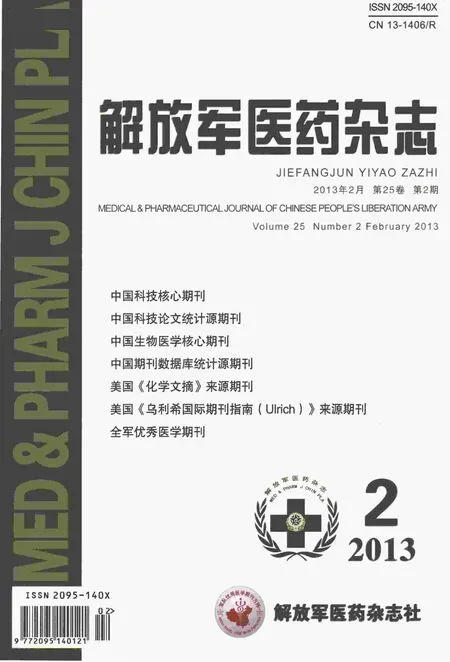晚期前列腺癌药物治疗研究进展
曹希亮,高江平
前列腺癌是男性最常见的恶性肿瘤之一。据估计,2012年美国前列腺癌新发病例为241 740例,死亡28 170例[1]。近年来我国前列腺癌发病率有明显的上升趋势,且大部分患者初诊时已出现局部进展或发生转移,药物治疗是我国前列腺癌的主要治疗方法[2]。但在2004年多西他赛上市以前晚期前列腺癌缺乏确切有效的治疗手段。近年来,晚期前列腺癌的药物治疗研究取得了令人鼓舞的进展。笔者综述了已经用于临床或者近期将用于临床晚期前列腺药物治疗的研究情况,为临床医务工作者和晚期前列腺癌患者提供新选择。
1 概述
目前多种内分泌治疗药物,包括甾体类和非甾体类抗雄激素药物、促性腺激素释放激素类似物等陆续被开发并应用于晚期前列腺癌的治疗,但治疗18~24个月后,多数激素敏感型前列腺癌将转变为雄激素非依赖性前列腺癌(AIPC)和激素抵抗性前列腺癌(HRPC),预后很差。多种化疗药物如米托蒽醌、紫杉醇、吉西他滨和雌二醇氮芥等曾被用于治疗HRPC多年,但仅能够在一定程度上缓解疼痛,改善患者生活质量,并不能延长总生存期[3-4]。近年来,前列腺癌的基础研究取得了突破性进展。既往多认为去势治疗的失败是由于癌细胞生长不再依赖雄激素。但现在的基础研究发现外源性雄激素被阻断后,前列腺癌细胞内雄激素生物合成酶逐渐出现过表达,使得肿瘤内雄激素合成增加,导致肿瘤细胞微环境中雄激素的实际浓度超过了血液中监测到的浓度,在多数晚期前列腺癌患者,雄激素受体信号仍是前列腺癌研究的重要途径[5-8]。基于上述认识,新型阻断雄激素合成药物的研究取得重要进展。随着分子生物学及生物工程技术的迅速发展,前列腺癌的免疫治疗、预防骨相关事件等药物的研发也取得了突破。临床试验证明,这些药物不但有助于缓解症状,也能延长晚期前列腺癌患者的总生存期。生物靶向治疗药物是晚期肿瘤治疗的热点,目前有多种生物靶向治疗药物进入不同的治疗前列腺癌临床研究阶段,有多种药物已经获得Ⅲ期临床试验结果或者正在进行Ⅲ期临床试验。
2 药物分类
2.1 阻断雄激素合成药物
2.1.1 阿比特龙(Abiraterone):阿比特龙是第一个被美国食品药品管理局(FDA)批准上市的治疗HRPC的阻断雄激素合成的口服剂型药物,其作用机制是不可逆抑制雄激素合成的限速酶细胞色素酶P450 c17(CYP17),能阻断睾丸、肾上腺、前列腺内雄激素的合成,且不会导致肾上腺功能不全[9-10]。一项多中心的随机对照Ⅲ期临床研究资料显示,在去势治疗失败的转移性前列腺癌并已接受化疗的患者中,阿比特龙-泼尼松组的死亡风险比安慰剂-泼尼松组降低了35.4%,总生存期较安慰剂组-泼尼松组延长近4个月(14.8个月vs 10.9个月),至前列腺特异性抗原(PSA)水平升高时间(10.2个月vs 6.6 个月)、无进展生存期(5.6 个月vs 3.6 个月)以及PSA应答率(29%vs 6%)等次要终点均优于阿比特龙-泼尼松组[11]。基于上述研究,2011年4月FDA批准醋酸阿比特龙联合泼尼松用于曾接受多西他赛治疗的转移性HRPC的治疗。目前,阿比特龙用于未接受化疗的转移性HRPC的临床试验中期分析显示,阿比特龙治疗组总生存期、影像学无进展生存期以及次要终点均优于对照组[12]。
2.1.2 Enzalutamide(MDV3100):Enzalutamide是继阿比特龙和卡巴他赛之后,新一代口服抗雄激素药物雄激素受体拮抗剂,Ⅲ期临床试验证明,可使多西他赛治疗失败的患者生存期受益,FDA已于2012年8月31日批准上市。与其他抗雄激素药物相比,该药通过三重机制发挥作用,它不但与雄激素受体结合更为紧密,还抑制受体核转位以及受体与DNA的结合,诱导肿瘤细胞凋亡[13]。一项多中心、双盲、随机Ⅲ期临床研究进一步证实,对于多西他赛治疗后的HRPC,Enzalutamide治疗组总生存期(18.4个月vs 13.6个月)、影像学无进展生存期(8.3个月vs 2.9个月)、至 PSA 进展时间(8.3个月 vs3.0个月)、PSA 应答率(54.0%vs 1.5%)及生活质量均显著优于安慰剂组[14]。目前,Enzalutamide用于未接受化疗的转移性HRPC的临床试验正在进行中。
2.1.3 TAK-700:TAK-700是一种新型非甾体雄激素抑制剂口服药物,其作用机制是高选择性抑制睾丸、肾上腺、前列腺肿瘤组织中的细胞色素酶CYP17A1的表达[15-16]。Ⅰ、Ⅱ期临床试验证实了其疗效[17],Ⅲ期临床试验正在进行中。
2.1.4 TOK-001:TOK-001可以同时破坏多种雄激素信号途径使得雄激素受体下调、竞争性抑制雄激素与受体结合、阻止雄激素受体向核内转位,也能抑制CYP17A1的表达[18]。目前该药尚处于Ⅰ、Ⅱ期临床试验阶段。
2.2 化学治疗药物
2.2.1 多西他赛(Docetaxel):多西他赛是第1个被证实能够延长晚期前列腺癌患者生存期的化疗药物,于2004年获得FDA批准上市。其作用机制是通过抑制细胞分裂所必需的微管蛋白而抑制癌细胞的分裂和增殖。另有研究发现,多西他赛可以起到抑制雄激素受体的作用[19]。Ⅲ期多中心临床研究报道,基于该药的化疗方案较其他方案可以显著延长患者的生存时间,研究中,3周多西他赛-泼尼松方案较米托蒽醌-泼尼松方案生存期延长2.4个月(16.5 个月 vs 18.9 个月)[20]。国内的一项用多西他赛一线治疗转移性HRPC的研究显示,多西他赛组总生存期比安慰剂组延长了近10个月[21]。目前正在进行多项基于多西他赛的标准化疗方案联合其他药物以提高疗效的临床试验[22]。
2.2.2 卡巴他赛(Cabazitaxel):卡巴他赛是一种新型的微管蛋白抑制剂,2010年6月FDA批准其上市用于治疗晚期HRPC,尤其是可用于多西他赛治疗失败的前列腺癌。Ⅲ期随机临床试验结果显示,对于转移性HRPC,卡巴他赛组比米托蒽醌组中位生存期延长了2.4个月(15.1个月 vs 12.7个月),死亡风险降低了30%,肿瘤无进展时间和至PSA进展时间等次要终点也优于对照组[23]。
2.3 免疫治疗药物
2.3.1 Provenge:Provenge作为第1种用于治疗实体肿瘤的免疫治疗药物,具有重要的临床意义。该药物采用抗原传递盒技术,利用前列腺酸性磷酸酶与粒细胞巨噬细胞集落刺激生物因子(GM-CSF)的融合重组蛋白作为抗原,在靶抗原和患者自身的树突细胞相结合后,致敏树突状细胞,被再灌注到患者体内以刺激免疫应答,通过刺激患者自身免疫系统对抗前列腺癌,特异性地杀死癌细胞。该药所激活的抗原特异性机制各参数与总生存期具有相关性[24]。Ⅲ期临床试验表明,在去势治疗失败的转移性前列腺癌并已接受化疗的患者中,治疗组的中位总生存期比安慰剂组长近4.1个月(25.8个月vs 21.7个月),死亡风险降低了22%[25]。另外一项系统分析也证实 Provenge对 HRPC的治疗价值[26]。该药于2010年4月底被FDA批准用于治疗晚期前列腺癌。
2.3.2 Ipilimumab:Ipilimumab是通过与CTLA4的结合来发挥作用。CTLA4是一种免疫抑制分子,通过与T细胞表面受体B7结合从而阻断T细胞活化的第2信号,进而抑制T细胞活化,保证免疫系统平衡并避免自身免疫性疾病的发生。但在肿瘤治疗中,CTLA4可能会抑制肿瘤免疫作用。该药干扰CTLA4与T细胞的结合不但能够激活CD8细胞,也激活了前列腺癌相关抗原特异性T细胞,可使免疫系统获得更加持久的抗肿瘤能力[27-28]。目前FDA已批准其用于黑色素瘤的治疗,治疗转移性HRPC的疗效尚需Ⅲ期临床试验验证。
2.3.3 PROSTVAC:PROSTVAC是基于痘病毒的疫苗,包括了PSA的一段DNA编码序列和3个共刺激分子(B7.1、ICAM-1和LFA-3)。在 II期临床试验中,PROSTVAC将患者的生存时间延长了8.5个月,病死率降低了44%[29]。其Ⅲ期临床试验结果值得期待。
2.4 治疗骨相关事件药物
2.4.1 氯膦酸盐:氯膦酸盐治疗晚期前列腺癌可以有效缓解骨骼疼痛,预防病理性骨折以及脊髓压迫等,还可显著降低各种骨折的发生率,延缓骨折的发生时间,缓解疼痛。更令人关注的是,一项多中心随机双盲安慰剂对照试验研究证实,氯膦酸盐可提高前列腺癌骨转移患者生存率,该研究中位随访时间11.5年,与安慰剂组相比,氯膦酸二钠治疗组的10年总生存率提高8%(9%vs 17%)[30]。提示前列腺癌发生骨转移时应该常规长期使用氯膦酸盐。
2.4.2 地诺单抗(Denosumab):地诺单抗是一种可与破骨细胞异化因子(RANKL)特异性结合的人源化的免疫球蛋白G2单克隆抗体,通过抑制RANKL,可预防或显著延迟去势抵抗性前列腺癌患者的骨转移发生时间。发表于《Lancet》杂志上的一项Ⅲ期随机研究针对基线无骨转移、PSA检测示骨转移风险高、HRPC患者,研究了地诺单抗对无骨转移生存时间的影响,结果显示,地诺单抗组无骨转移生存期较安慰剂组显著延长(29.5个月 vs 25.2个月),至骨转移时间也较安慰剂组显著延长(33.2个月 vs 29.5个月),但两组的总生存期无显著差异[31]。另一项随机、双盲、对照、多中心研究表明,地诺单抗预防前列腺癌导致的骨相关事件的效果优于新型氯膦酸盐制剂唑来磷酸[32]。该药于2010年7月被FDA批准用于实体肿瘤骨转移的治疗。
2.4.3 氯化镭-223(Alpharadin):氯化镭-223是一种发射α射线的放射性药物,利用氯化镭-223释放的α射线,精确地靶向作用于转移到骨骼组织的癌细胞,从而最大限度减少对周围正常细胞,特别是骨髓的损害;其半衰期为11.4 d,未被骨转移灶吸收的氯化镭-223会迅速被肠道清除,是第1种显示出令人信服的抗肿瘤效应的放射性药物,能够使得PSA水平降低,疼痛得到缓解,也延长了生存期。在Ⅱ期临床试验基础上,随机双盲对照Ⅲ期临床试验探索了在标准治疗基础上联合氯化镭-223或安慰剂治疗伴有症状性骨转移的HRPC的疗效和安全性,结果显示氯化镭-223组骨转移患者的总生存期(14.0个月vs 11.2个月)和首次骨相关事件(13.6个月vs 8.4个月)较安慰剂组显著延长,且氯化镭-223治疗的安全性良好[33-34]。
2.5 生物靶向治疗
2.5.1 Cabozantinib:Cabozantinib是酪氨酸激酶MET和血管内皮生长因子受体2(VEGFR-2)的抑制剂,对转移和血管生成有明显的抑制作用。其作用机制为:使转移癌细胞广泛凋亡,减少肿瘤侵犯和转移,减少肿瘤细胞核上皮细胞增殖,阻抑骨转移进展以及崩解肿瘤血管[35]。在2012年美国临床肿瘤学会年会上公布的一项研究结果表明,有76%的转移性前列腺癌患者在接受Cabozantinib的治疗后,骨骼扫描显示肿瘤部分或全部萎缩。此外,在使用麻醉剂对抗骨疼痛的患者中,67%的患者疼痛减轻,56%的患者停止使用麻醉剂或减少用量[36]。但没有数据显示Cabozantinib能延长患者的生存期。Ⅲ期临床试验正在全世界240个医疗中心进行。
2.5.2 Tasquinimod:Tasquinimod是一种具有多效性的药物,其包括免疫调节、抗血管生成和抗转移作用。Ⅱ期临床试验在肿瘤无进展生存期方面显示出其优越性[37]。治疗无明显全身症状的转移性前列腺癌的随机、对照、双盲Ⅲ期临床试验正在进行中。
2.5.3 Custirsen:Custirsen是一种反义寡核苷酸,可阻断凝聚素的产生,而凝聚素是一种细胞存活蛋白,通常在一些肿瘤中会过表达,且对抗癌治疗药物有反应[38]。早期临床研究结果表明,Custirsen联合化疗可降低前列腺癌相关性疼痛并改善总生存率[39-40]。研究人员正在进行 Custirsen联合化疗用于去势抵抗性前列腺癌的两项Ⅲ期临床试验。该药已经进入FDA的快速通道,预计将于2013年出结果。
2.5.4 贝伐单抗(Bevacizumab):贝伐单抗是一种重组的人类单克隆IgG1抗体,通过抑制人类VEGF的生物学活性而起作用,是美国第1个获得批准上市的抑制肿瘤血管生成的药物。一项有关贝伐单抗治疗前列腺癌的Ⅲ期随机、对照、双盲临床试验结果发现,多西他赛联合泼尼松方案中加入贝伐单抗后,肿瘤无进展生存期显著延长,但总生存期并无显著延长[41]。
综上所述,近年来晚期前列腺药物治疗研究取得了突破性进展。随着对前列腺癌发病机制的认识越来越深,必将有更多的新药问世。这不仅给临床医生带来了新的方法,也带来了新的挑战。如何根据患者实际情况制订最佳的治疗计划,在恰当的时机使用恰当的药物,使患者最大限度获益,还需要更多的探索。
[1]Siegel R,Naishadham D,Jemal A.Cancer statistics,2012[J].CA Cancer J Clin,2012,62(1):10-29.
[2]马春光,叶定伟,李长岭,等.前列腺癌的流行病学特征及晚期一线内分泌治疗分析[J].中华外科杂志,2008,46(12):921-925.
[3]Tannock I,Osoba D,Stockler M R,et al.Chemotherapy with mitoxantrone plus prednisone or prednisone alone for symptomatic hormone-resistant prostate cancer:A Canadian randomized trial with palliative end points[J].J Clin Oncol,1996,14(6):1756-1764.
[4]Kantoff P W,Halabi S,Conaway M,et al.Hydrocortisone with or without mitoxantrone in men with hormone refractory prostate cancer:results of the cancer and leukemia group B 9182 study[J].J Clin Oncol,1999,17(8):2506-2513.
[5]Holzbeierlein J,Lal P,Latulippe E,et al.Gene expression analysis of human prostate carcinoma during hormonal therapy identifies androgen-responsive genes and mechanisms of therapy resistance[J].Am J Pathol,2004,164(1):217-227.
[6]Locke J A,Guns E S,Lubik A A,et al.Androgen levels increase by intratumoral de novo steroidogenesis during progression of castration-resistant prostate cancer[J].Cancer Res,2008,68(15):6407-6415.
[7]Mostaghel E A,Page S T,Lin D W,et al.Intraprostatic androgens and androgen-regulated gene expression persist after testosterone suppression:therapeutic implications for castration-resistant prostate cancer[J].Cancer Res,2007,67(10):5033-5041.
[8]Attard G,Reid A,Auchus R,et al.Clinical and biochemical consequences of CYP17A1 inhibition with abiraterone given with and without exogenous glucocorticoids in castrate men with advanced prostate cancer[J].J Clin Endocrinol Metab,2012,97(2):507-516.
[9]Handratta V D,Vasaitis T S,Njar V C,et al.Novel C-17-heteroaryl steroidal CYP17 inhibitors/antiandrogens:synthesis,in vitro biological activity,pharmacokinetics,and antitumor activity in the LAPC4 human prostate cancer xenograft model[J].J Med Chem,2005,48(8):2972-2984.
[10]Attard G,Belldegrun A S,de Bono J S.Selective blockade of androgenic steroid synthesis by novel lyase inhibitors as a therapeutic strategy for treating metastatic prostate cancer[J].BJU Int,2005,96(9):1241-1246.
[11]de Bono J S,Logothetis C J,Molina A,et al.Abiraterone and increased survival in metastatic prostate cancer[J].N Engl J Med,2011,364(21):1995-2005.
[12]Ryan C J,Smith M R,De Bono J R,et al.Interim analysis(IA)results of COU-AA-302,a randomized,phase III study of abiraterone acetate(AA)in chemotherapynaive patients(pts)with metastatic castration-resistant prostate cancer(mCRPC) [J].J Clin Oncol,2012,30(Suppl 5):4518.
[13]Tran C,Ouk S,Clegg N J,et al.Development of a second-generation antiandrogen for treatment of advanced prostate cancer[J].Science,2009,324(5928):787-790.
[14]Scher H I,Fizazi K,Saad F,et al.Increased survival with enzalutamide in prostate cancer after chemotherapy[J].N Engl J Med,2012,367:1187-1197.
[15]Yamaoka M,Hara T,Hitaka T,et al.Orteronel(TAK-700),a novel non-steroidal 17,20-lyase inhibitor:Effects on steroid synthesis in human and monkey adrenal cells and serum steroid levels in cynomolgus monkeys[J].J Steroid Biochem Mol Biol,2012,129(3-5):115-128.
[16]Kaku T,Hitaka T,Ojida A,et al.Discovery of orteronel(TAK-700),a naphthylmethylimidazole derivative,as a highly selective 17,20-lyase inhibitor with potential utility in the treatment of prostate cancer[J].Bioorg Med Chem,2011,19(21):6383-6399.
[17]Agus D B,Stadler W M,Shevrin D H,et al.Safety,efficacy,and pharmacodynamics of the investigational agent TAK-700 in meta-static castration-resistant prostate cancer(mCRPC):updated data from a phase Ⅰ/Ⅱstudy[J].J Clin Oncol,2011,29(Suppl):abstract 4531.
[18]Vasaitis T S,Bruno R D,Njar V C.CYP17 inhibitors for prostate cancer therapy[J].J Steroid Biochem Mol Biol,2011,125(1-2):23-31.
[19]Gan L,Chen S,Wang Y,et al.Inhibition of the androgen receptor as a novel mechanism of taxol chemotherapy in prostate cancer[J].Cancer Res,2009,69(21):8386-8394.
[20]Tannock I F,de Wit R,Berry W R,et al.Docetaxel plus prednisone or mitoxantrone plus prednisone for advanced prostate cancer[J].N Engl J Med,2004,351(15):1502-1512.
[21]沈益君,卞晓洁,谢湖阳,等.多西他赛联合泼尼松或米托蒽醌联合泼尼松一线治疗转移性激素抵抗性前列腺癌的远期疗效和安全性分析[J].中华外科杂志,2012,50(6):539-542.
[22]Galsky M D,Vogelzang N J.Docetaxel-based combination therapy for castration-resistant prostate cancer[J].Ann Oncol,2010,21(11):2135-2144.
[23]de Bono J S,Oudard S,Ozguroglu M,et al.Prednisone plus cabazitaxel or mitoxantrone for metastatic castrationresistant prostate cancer progressing after docetaxel treatment:a randomised open-label trial[J].Lancet,2010,376(9747):1147-1154.
[24]Sheikh N A,Petrylak D,Kantoff P W,et al.Sipuleucel-T immune parameters correlate with survival:an analysis of the randomized phase 3 clinical trials in men with castration-resistant prostate cancer[J].Cancer Immunol Immunother,2013,62(1):137-147.
[25]Kantoff P W,Higano C S,Shore N D,et al.Sipuleucel-T immunotherapy for castration-resistant prostate cancer[J].N Engl J Med,2010,363(4):411-422.
[26]Sonpavde G,Di Lorenzo G,Higano C S,et al.The role of sipuleucel-T in therapy for castration-resistant prostate cancer:a critical analysis of the literature[J].Eur Urol,2012,61(4):639-647.
[27]Pardoll D,Drake C.Immunotherapy earns its spot in the ranks of cancer therapy[J].J Exp Med,2012,209(2):201-209.
[28]Fong L,Kwek S S,O'Brien S,et al.Potentiating endogenous antitumor immunity to prostate cancer through combination immunotherapy with CTLA4 blockade and GM-CSF[J].Cancer Res,2009,69(2):609-615.
[29]Kantoff P W,Schuetz T J,Blumenstein B A,et al.O-verall survival analysis of a phase II randomized controlled trial of a Poxviral-based PSA-targeted immuno-therapy in metastatic castration-resistant prostate cancer[J].J Clin Oncol,2010,28(7):1099-1105.
[30]Dearnaley D P,Mason M D,Parmar M K,et al.Adjuvant therapy with oral sodium clodronate in locally advanced and metastatic prostate cancer:long-term overall survival results from the MRC PR04 and PR05 randomised controlled trials[J].Lancet Oncology,2009,10(9):872-876.
[31]Smith M R,Saad F,Coleman R,et al.Denosumab and bone-metastasis-free survival in men with castration-resistant prostate cancer:results of a phase 3,randomised,placebo-controlled trial[J].Lancet,2012,379(9810):39-46.
[32]Fizazi K,Carducci M,Smith M,et al.Denosumab versus zoledronic acid for treatment of bone metastases in men with castration-resistant prostate cancer:a randomised,double-blind study[J].Lancet,2011,377(9768):813-822.
[33]Nilsson S,Franzén L,Parker C,et al.Bone-targeted radium-223 in symptomatic,hormone-refractory prostate cancer:a randomised,multicentre,placebo-controlled phase Ⅱ study[J].Lancet Oncol,2007,8(7):587-594.
[34]Parker C,l Heinrich D,O'Sullivan J M,et al.Overall survival benefit and safety profile of radium-223 chloride,a first-in-class alpha-pharmaceutical:Results from a phaseⅢrandomized trial(ALSYMPCA)in patients with castration-resistant prostate cancer(CRPC)with bonemetastases [J].J Clin Oncol, 2012,30(Suppl 5):8.
[35]Yakes F M,Chen J,Tan J,et al.Cabozantinib(XL184),a novel MET and VEGFR2 inhibitor,simultaneously suppresses metastasis, angiogenesis, and tumor growth[J].Mol Cancer Ther,2011,10(12):2298-2308.
[36]Hussain M,Smith M R,Sweeney C,et al.Cabozantinib(XL184)in metastatic castration-resistant prostate cancer(mCRPC):results from a phaseⅡrandomized discontinuation trial[J].J Clin Oncol,2011,29(Suppl):abstr 4516.
[37]Pili R,Haggman M,Stadler W M,et al.PhaseⅡ randomized, double-blind, placebo-controlled study of tasquinimod in men with minimally symptomatic metastatic castrate-resistant prostate cancer[J].J Clin Oncol,2011,29(32):4022-4028.
[38]Shiota M,Zoubeidi A,Kumano M,et al.Clusterin is a critical downstream mediator of stress-induced YB-1 transactivation in prostate cancer[J].Mol Cancer Res,2011,9(12):1755-1766.
[39]Chi K N,Hotte S J,Yu E Y,et al.A randomized phase II study of docetaxe and prednisone with or without OGX-011 in patients with metastatic castration-resistant prostate cancer[J].J Clin Oncol,2010,28(27):4247-4254.
[40]Saad F,Hotte S,North S,et al.Randomized phase II trial of Custirsen(OGX-011)in combination with docetaxel or mitoxantroneas second-line therapy in patients with metastatic castrate-resistant prostate cancer progressing after first-line docetaxel:CUOG trial P-06c[J].Clin Cancer Res,2011,17(7):5765-5773.
[41]Kelly W K,Halabi S,Carducci M A,et al.A randomized,double-blind,placebo-controlled phaseⅢ trial comparing docetaxel,prednisone,and placebo with docetaxel,prednisone,and bevacizumab in men with metastatic castration-resistant prostate cancer(mCRPC):Survival results of CALGB 90401[J].J Clin Oncol,2010(suppl):abstr CBA 4511.

